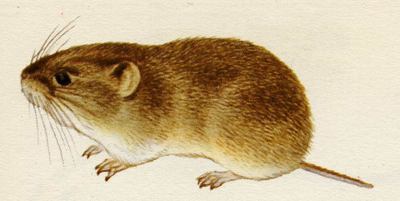Pests
Microtus (Sumeriomys) socialis (Pallas, 1770) - Social vole (Meadow mouse).
Systematic position.
The class Mammalia, order Rodentia, family Cricetidae, subfamily Microtinae, genus Microtus, subgenus Sumeriomys. The species contains about 10 subspecies (from different information sources), 7 subspecies in the fauna of the former USSR.Biological group.
Rodent pests.Morphology and biology.
Body length of the large adult is up to 122 mm, with tail length up to 31 mm (25-31% of body length); body length of the small-sized animals is up to 105 mm and 24 mm for the tail (23.8-26.8%). Ears are short, hardly projecting from hair. The coloration of body dorsum varies from light, sandy to dark, ochre-gray; body ventrum from light, silvery to ash-grey. The tail is light, monochrome or gently bicolorate. 5 calluses on back foot. Diploid set of chromosomes: 62. An inhabitant of dry gramineous and gramineous-wormwood steppes and of semi-deserts, plains and foothills. In mountains it reaches up to 1400 m above sea level in the Caucasus and up to 2000 m in Kazakhstan (western Tien-Shan).Distribution.
Iran, Turkey, Syria. In the former USSR it has three isolated foci, within the limits of all areas the distribution of the species shows a mosaic picture. 1) Southern-Ukrainian focus - steppe part of Crimea and south of Ukraine from lower Dnieper to Melitopol in the east and Dnepropetrovsk in the north; 2) Caspian-Caucasian focus - Rostov Region, Stavropol Territory, Astrakhan Region, Kalmykia, Dagestan, Transcaucasia (Azerbaijan, Georgia, Armenia); 3) Kazakhstan - Central, Southern, and Southeastern parts.Ecology.
Well adapted to survival under conditions of arid climate, with intensive digging activity. The type of shelter structure does not differ essentially from that of the Common vole, but the shelters are much more complex, with greater number of hole openings, paths, underground passages, female and storage chambers. Takes 1st place among gray voles on degree of digging activity. A typical phytophage, feeding on many species of cultural and wild herbaceous plants, but preferring cereals and legumes. Autumn seeds, especially those of cereals, prevail in ration, being stored in quantities for winter. Reproduction lasts the whole year, but sharply reduced in frequency or completely ceasing under conditions of cold or droughty weather. Usually 3-5 broods during the year, with 4 to 18 young voles in a brood, 6-8 on the average. The population density is sharply augmented during mass outbreaks, reaching 90 thousand hole openings per hectare in some fields.Economic significance.
Takes 2nd place after Common vole for economic significance. During rises of population, the species invades considerable areas sown to main agricultural crops and pastures, where it completely destroys plants and leaves large quantity of hole openings in ground. The distribution area permanently extends in the agricultural lands appearing after forests are cut in mountain regions, at irrigation units and on irrigable lands in semi-deserts. In addition, within the limits of geographic area, the area of natural reserves is increasing due to sowings of perennial grasses, hay fields, pastures, and presense of fallow lands, and forest shelter-belts.Reference citations:
Dal' S.K. 1954. Fauna of Armenian SSR. Vertebrate animals. Yerevan: Izd. AN Armenian SSR. V. 1: 415.Khodashova K.S. 1953. Life-forms of the rodents of lowland Kazakhstan and some regularities in their geographic distribution. Proceedings of the Institute of Geography AN SSSR, 54. Moscow. 33-194 p. (In Russian)
Kokhiya S.S. 1968. Social vole (Microtus socialis Pall.) in Georgia. Tbilisi: Metsniereba. 135 pp.
Rodionov Z.S. 1924. A biology of Social vole and experience of control in Transcaucasia. Leningrad. 191 pp.
Sokolov I.I., ed. 1963. Mammalian fauna of the USSR. Part I. Leningrad: Izd. AN SSSR. 638 pp. (In Russian)
Vereshchagin N.K. 1959. Mammals of the Caucasus. Moscow-Leningrad: Izd. AN SSSR. 703 pp.


